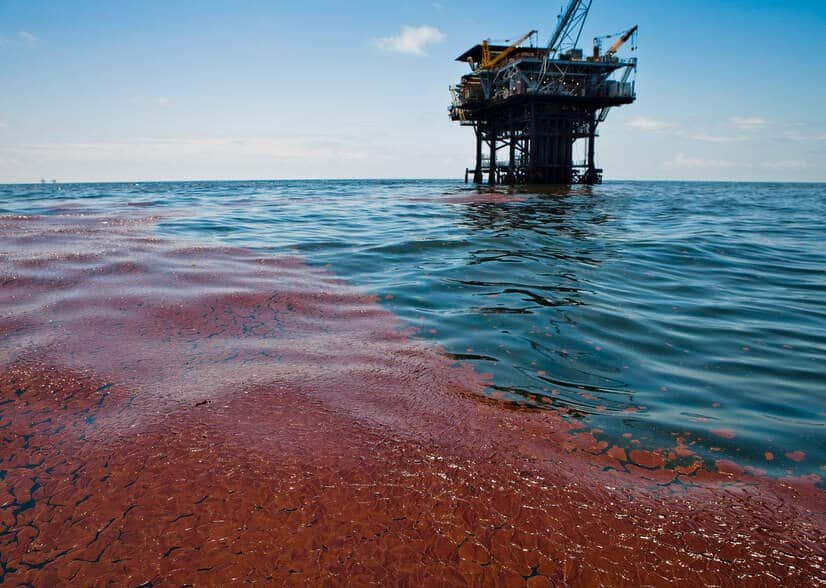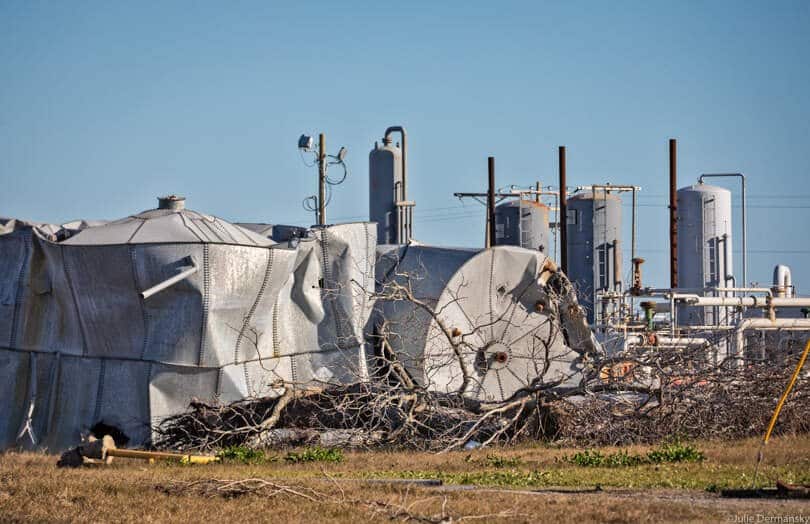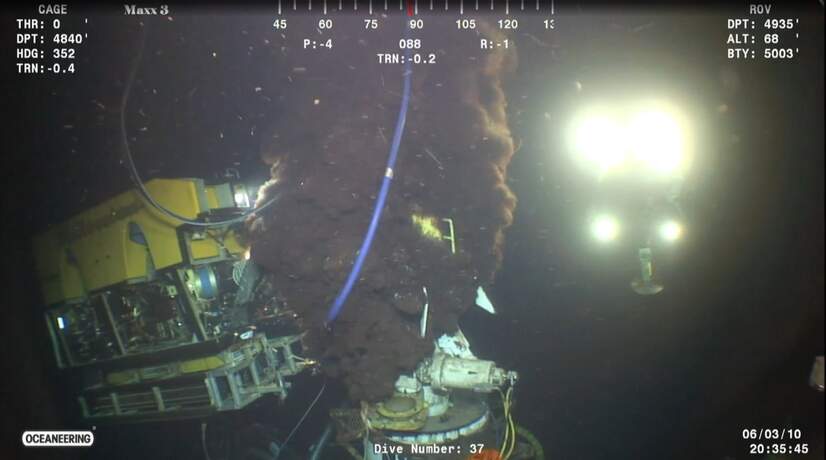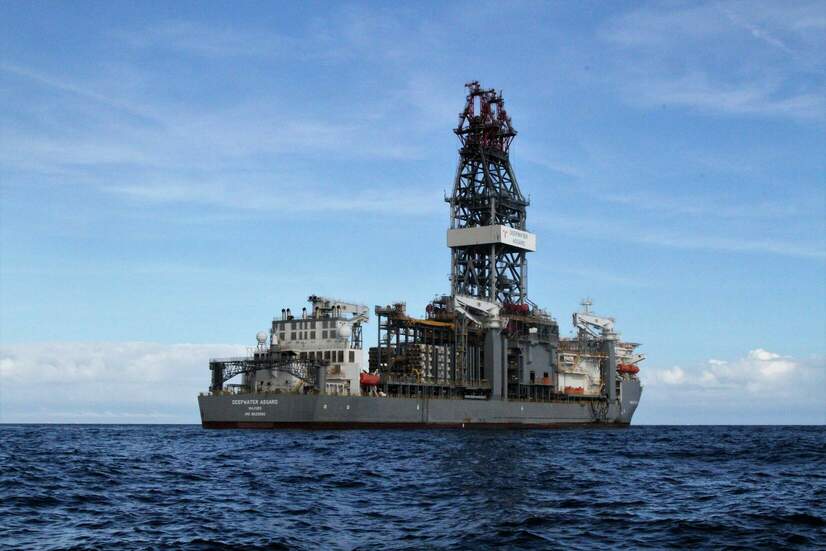It was Thursday, October 22, 2020, when the crew aboard the Transocean Deepwater Asgard, an ultra-deepwater rig in the Gulf of Mexico, started monitoring a weather disturbance in the nearby Caribbean Sea that bore the tell-tale signs of a forming hurricane.
But the Asgard, which was drilling an oil well in the waters about 225 miles south of Baton Rouge, Louisiana, had other pressing matters to deal with. That same day, the oil well it was drilling more than a mile below the water’s surface experienced a kick — an eruption of oil, gas, or other fluids from deep underground up the drill pipe. If not properly controlled, this type of incident can sometimes lead to a blowout.
Kicks aren’t necessarily all that uncommon during offshore drilling. What happened over the following week, however, not only left the crew of the Asgard in deadly peril and caused over $5 million in damages to the ship and its equipment, but also, according to experts, risked an oil spill potentially several times the size of the largest oil spill in U.S. waters.
Events out to sea on the Asgard received little or no media attention at the time. An investigation by DeSmog reveals how close the Gulf Coast may have been to a major oil industry disaster this past fall.
“This could easily have become another Deepwater Horizon catastrophe,” said Rick Steiner, a marine conservationist and former professor at the University of Alaska whose background includes advising on the response to that spill, the Exxon Valdez, and many others worldwide. “Secretary [of the Interior Deb] Haaland should order a comprehensive independent inquiry into the Deepwater Asgard incident, the failures leading up to it, and what needs to be done to prevent another such near casualty in the future.”
In a worst-case scenario disaster, the well that the Asgard was drilling was capable of spilling 313,100 barrels of oil per day for 99 days, federal filings from Beacon Offshore Energy, the production company, show. That rate, Steiner noted, would be “many times that of the Deepwater Horizon/Macondo blowout.”
An uncontrolled blowout of the well, Beacon’s filings predicted, could unleash a total of more than 25.3 million barrels of oil — more oil than the roughly 20 million barrels the entire U.S. consumes in a day.
The Asgard incident comes as climate scientists warn that hurricanes are likely to become increasingly volatile, making them not only more difficult to predict, but also more difficult to evade, for those onshore and off. Last year not only brought a record-shattering number of hurricanes that made U.S. landfall, it also brought a record-breaking number of hurricanes that, like Zeta, rapidly intensified, making the storms harder to predict and giving people less time to prepare.
“I’m definitely concerned about the increased intensity of storm seasons,” said Sarah Giltz, a marine scientist with environmental group Oceana, which published a report in January warning about the hazards of offshore drilling. “And when we have a season like we had last year, with so many storms, it’s really scary how much infrastructure we have out there and the potential for another Deepwater Horizon-like disaster.”

“No Other Options but to Obey Orders”
As Hurricane Zeta began forming, the crew on the Asgard was busy responding to the well kick and to a failure of the well’s cement liner that was also discovered on October 22, according to federal records provided to Steiner and shared with DeSmog. Then, on Saturday, October 24, the Asgard’s “iron roughneck,” a piece of equipment used to disconnect segments of the rig’s drill pipe, broke down, requiring work on the well to pause for repairs that stretched into Sunday the 25th.
As the crew finally resumed work on the well, Zeta made landfall on the Yucatan peninsula as a Category 1 hurricane on Monday, October 26, then kept moving towards the Asgard, gaining strength.
Forecasts from the National Oceanic and Atmospheric Administration (NOAA) already showed that the Asgard was positioned right inside Zeta’s forecast cone. But oil and gas companies often rely on private forecasts to predict the weather in the Gulf of Mexico. As Zeta continued to draw closer, “the drillship personnel were consistently advised by forecasters that ‘the [rig] location is not expected to see direct, significant impacts,’” the U.S. Bureau of Safety and Environmental Enforcement (BSEE) later wrote.
Oil rig crews often evacuate from hurricanes, sometimes departing by helicopter and leaving only a skeleton crew aboard to ride out the storm. On the Asgard, instead of allowing some of the crew to leave, new crew members were sent out to the rig as Zeta drew nearer, according to the law firm Arnold & Itkin. That law firm now is representing at least eight aboard the Asgard, who have filed suit alleging that management left the crew in harm’s way.
As Zeta drew closer, the Asgard’s crew had managed to install a device called a RTTS, which offshore rigs often use to temporarily plug oil wells while they evacuate from hurricanes. Fortunately, two installation tests both proved successful, the company later reported.
On Tuesday, October 27, the crew was busy preparing to move the Asgard away from the storm’s path when, according to legal complaints later filed by several crew members and obtained by DeSmog: “calls started coming in from the shoreside offices of the Transocean and Beacon stating that the Deepwater Asgard needed to stay latched and continue operations.” Preparations to evade the storm were halted and a 4:00 p.m. conference call was scheduled for management onshore to weigh in.
“At the 4:00 p.m. phone call, Transocean and Beacon ordered the vessel to stay latched despite Hurricane Zeta headed directly toward them,” the complaint continued. “Plaintiff, along with other crewmembers on board, strongly disagreed with the decision to stay latched but had no other options but to obey orders.”
Check out these waves from Hurricane #Zeta on an oil platform in the Gulf of Mexico. This specific rig is south of Louisiana, and was near the eyewall of Zeta. They recorded wind gusts exceeding 150 mph, and waves over 50 feet!
— Jennifer Lambers ⛈ (@jlamberswx) October 28, 2020
📸: Brian Stout pic.twitter.com/yF8D4gKaJo
In the Red
By Wednesday morning, the Asgard found itself in Zeta’s eyewall — with wind gusts reaching 152 miles per hour and sea swells of 30 feet — and still latched to the oil well a mile below the churning seas by a long metal pipe called a riser.
Oil rigs like the Asgard tend to float around a bit even under ideal conditions, so they have developed a very simple system to decide when they have drifted too far from the oil well below for the rig and the riser to bear. Envision a set of imaginary rings drawn around the point directly above the undersea oil well. The innermost ring is green, representing the safe zone where the rig should remain. The next ring is called the “yellow watch circle,” where danger is growing. An outer ring is called the “red watch circle” and when you enter it, it’s time to hit the rig’s emergency disconnect button.At that point, the machinery atop the wellhead is designed to split apart, releasing a “lower marine riser package” (LMRP) from the lower blowout preventer and allowing the LMRP, riser pipe, and the ship to be freed from the wellhead below. If everything in that emergency system works correctly, no oil should spill, even if everything else fails.
The emergency disconnect system, however, can sometimes fail. It did on the Deepwater Horizon, another Transocean ship. One of the crew members on board the Asgard during Zeta was Christopher Pleasant, who was aboard the Deepwater Horizon nearly 11 years ago when that catastrophe struck. Pleasant testified that he personally hit the emergency disconnect system on the Deepwater Horizon after the deadly explosion aboard — but on that rig, the emergency disconnect system failed and the well blew out.
As Zeta raged last fall, the Asgard was blown into the red watch circle despite using all six of its thrusters at full power to try to stay near the wellhead below. At roughly 9:40 a.m. on October 28, the rig’s captain ordered an emergency disconnect in the midst of the hurricane’s sustained 109 mile per hour winds, waves as tall as an Olympic high-diving platform, and strong currents.
Twenty-four seconds ticked away as the emergency disconnect system activated. The rig was 159 feet from the well — inside the red watch circle — when the button was hit, and was driven another 11 feet further away from the wellhead before the LMRP finally broke clear.
“However, by that point it was too late,” Pleasant’s lawsuit alleges. The crew could not prevent damage to the rig and found themselves nearly at the hurricane’s mercy. “The vessel lost an engine and began taking on water in two of the thrusters. Engineers aboard the vessel had to rig tarps to stop the water from reaching the remaining thrusters so the Captain could control the vessel.”
The riser dangling below the ship multiplied the danger. Equipment normally used to help keep the riser stable in high seas was not in storm-ready shape — including some replacement parts that had sat aboard the Asgard waiting to be installed for months, the lawsuit adds, “because the Defendants did not want to stop production.”
At roughly 10:00 a.m., the out-of-control riser struck the Asgard inside the “moonpool,” the donut hole in the ship through which the long metal pipe runs, federal documents show.
“Yeah, that would scare the crap out of me,” Leo Linder, who worked for five years on Transocean ships, told DeSmog. Linder was aboard the Deepwater Horizon with Pleasant when that well blew out. “That would not be something you’d see ever really.”
The Asgard was tossed around in the storm for hours. At some point, the LMRP at the bottom of the riser struck the sea floor and sustained damage.
The Deepwater Asgard was blown roughly two nautical miles northwest of the wellhead before it finally came to a stop. To navigate back to the wellhead, the ship had to traverse the same uneven seafloor, again striking the LMRP as it limped back to the well.
Though no spill was reported, experts interviewed by DeSmog suggested that, from the available documentation, it’s not possible to be certain no oil was spilled as a result of these events.
The Asgard incident came just over a month after the 10th anniversary of the sealing of the Macondo well in late September 2010 after the Deepwater Horizon blowout. Estimates of the total oil that flowed into the Gulf from the Macondo well reached nearly 5 million barrels, makingit the worst accidental spill in the oil industry’s history — and about one-fifth the size of the spill that, according to Beacon’s filings, the well the Asgard returned to was capable of unleashing.
Transocean and Beacon declined to answer questions about the Asgard incident, citing ongoing litigation.
A Double-Whammy
Asked what a by-the-book response to an approaching hurricane might be, Linder pointed to a lack of clear standards. “I wish there was a book that actually dictated to the production companies what that is, because they’re given so much leniency, they’re given so much latitude as to what is in their best interest,” he said. “And there are certain regulations, I guess, but it’s usually so ambiguous as to what’s best for the rig, so that the production company really has to decide what to do, what is their position and then the contractor — it is a battle between those two entities as to what to do.”
Financial pressures often push companies like Beacon to urge faster drilling and companies like Transocean to defer maintenance.
“You kind of get a double-whammy because the production company wants you to complete the well as soon as possible,” he said, “But as far as the maintenance goes, I mean Transocean — and they got dinged for this on the [Deepwater] Horizon too — you know, if you go into dry dock and you fix everything, you’re not getting a day rate.”
Linder’s point about the willingness of federal regulators to defer to offshore drillers was echoed by other observers.
“Anything that’s complex is difficult to administer and easy to evade,” explained Megan Milliken Biven, a former federal analyst for the Bureau of Ocean Energy Management, adding that federal oversight offshore is so lax that currently, there is no agency that tracks COVID-19 outbreaks on offshore rigs and that in some cases, companies in the Gulf of Mexico use incarcerated laborers as offshore deckhands.
“There’s a lot of white-collar folks in government who don’t necessarily appreciate the kind of intimidation and unprofessionalism that takes place out in the Gulf,” she added. “It’s pushed to a point of catastrophe.”
While it’s not clear why management pushed for the Asgard to remain in Zeta’s path, there’s no question that in 2020 the oil and gas industry was under extraordinary financial pressure. In October, just 12 offshore oil rigs were operating in the Gulf of Mexico, down from 21 rigs the year before, according to a Baker Hughes rig count — and by November, the year’s record-smashing hurricanes had shut in a total of over 40 million barrels from the Gulf’s oil production.

Observers warned in September that Transocean was “struggling” to avoid bankruptcy. In fact, on October 22, the same day that the Asgard experienced the well kick, Transocean had told Texas regulators that it planned to lay off the Asgard’s crew in December, citing a slowdown in offshore drilling activity.
The production company, Beacon, was formed in 2016 by Blackstone Energy Partners — a subsidiary of the private equity behemoth Blackstone, which describes itself as “investing capital on behalf of pension funds, large institutions, and individuals” and which, in January reported $619 billion in assets under management.
Linder noted that, unlike oil giants such as BP and Shell, Beacon has little firsthand experience contending with hurricanes in the Gulf of Mexico.
In February, the Asgard came up by name during Transocean’s fourth quarter earnings call. “And finally, in the Gulf of Mexico, the Asgard recently completed a successful campaign for Beacon Offshore in January,” Transocean CEO Jeremy Thigpen said. “The rig is now warm-stacked [in port], but as you all know, the Asgard is one of the most technically advanced and most well-respected assets in the U.S. Gulf of Mexico. As such, we’re actively bidding her into multiple opportunities.”
He made no mention of the hurricane or the damage it caused.
Offshore Leasing Paused — But Drilling Continues
The Asgard incident took place just a week before the 2020 election — but information about it was not made public by federal regulators until late March, when the Bureau of Safety and Environmental Enforcement (BSEE) quietly issued a safety alert describing the damage the Asgard endured and recommending, among other steps, that offshore drillers “consider” how they’d respond if a storm approached while a crew is wrestling with a problem well.
In 2018, Trump-appointee Scott Angelle, who served as the head of BSEE until January, drew scrutiny from the New York Times for his “close personal and recent ties to the oil and gas industry” and for rolling back safety measures adopted after the Deepwater Horizon disaster.
BSEE declined to answer questions from DeSmog, including a question about whether political pressure played a role in delaying reporting on the incident, citing an ongoing investigation into the incident. In October, the agency published recommendations for ways that offshore drillers and contractors could improve their hurricane response plans, after auditing hurricane plans covering more than half of the manned sites in the Gulf.
The Biden administration paused new oil and gas leasing in the Gulf on January 27, 2021, but officials have emphasized that the leasing pause does not mean that offshore drilling has been stopped.
“The pause in new oil and gas lease sales gives us space to look at the federal fossil fuel programs that haven’t been meaningfully examined or modernized in decades,” Interior Secretary Deb Haaland said on March 25 as she kicked off a virtual public forum on offshore oil and gas leasing. “I want to be clear that the pause on these lease sales does not impact permitting and development on valid existing leases. Further, oil and gas companies have amassed thousands of permits to drill on 38 million acres of public lands and oceans — an area larger than the state of Iowa.”
Unknown Impact
The well the Asgard was drilling during Zeta was listed as permanently abandoned on December 4, 2020. But experts are still trying to determine what the environmental impact may have been.
Satellite images provided by SkyTruth from the Green Canyon area in the Gulf of Mexico show one oil slick near the Asgard following the well kick, but SkyTruth was able to identify a known oil seep in that location using data from Texas A&M University and Florida State University that would most likely be the source of that oil. The Coast Guard’s National Response Center received no reports of any spills associated with the Asgard, a spokesperson told DeSmog.
But the Asgard incident took place in waters well over a mile deep — even deeper than the Deepwater Horizon incident — meaning not only could controlling a spill be more difficult but also that it’s possible for oil spills to remain underwater and undetected from the surface.

“For example, it has been estimated that 50 percent of the Deepwater Horizon oil, and 100 percent of the natural gas that came from the wellhead never made it to the surface, but instead remained entrained in deep ocean water layers and spread in large underwater plumes,” Steiner said. “Thus, even if there was a substantial spill from the Asgard GC 895 well, it likely would not have been detected from the surface.”
Scott Eustis, the community science director of environmental group Healthy Gulf, noted that the Green Canyon area is so remote that it’s extremely difficult for regular people and environmental groups to visit. “We can’t get out to Green Canyon,” he said. “It’ll cost you $1,500 to think about flying to Green Canyon.”
That part of the Gulf is also ecologically sensitive, he said. “It’s a place where, for example, whale sharks regularly feed,” he added, noting that historically, the endangered Rice whale might have populated the area. “It’s in the migration line for a lot of our endangered sea turtles too.”
“This kind of incident for us is very distressing,” Eustis added.
BSEE did not answer questions about whether the blowout preventer and wellhead were inspected following the storm. And without that inspection data, the possibility that the wellhead or blowout preventer were damaged cannot be ruled out.
As drilling companies continue to push outwards into deeper waters and a changing climate makes hurricanes in the Gulf of Mexico like Zeta increasingly volatile, some say that a regulatory approach that, in part, focuses on recommendations to drillers offers so little protection against future catastrophe that it’s time for a more ambitious change of course.
“The Biden administration’s January 27 Executive Order temporarily pausing oil and gas permitting on federal lands and waters needs to be made permanent,” said Steiner. “We cannot afford another Deepwater Horizon — or Asgard.”
Subscribe to our newsletter
Stay up to date with DeSmog news and alerts






